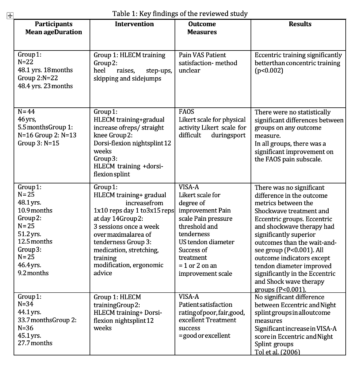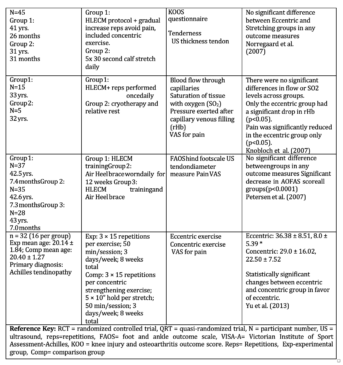Department of Physical Therapy, Faculty of Applied Medical Sciences, Jazan University, Saudi Arabia
Background: All of the studies included in the analysis developed scales to assess a variety of outcomes, including tenderness, patient experience, return to sport, degree of improvement, and physical activity engagement.
Method: In terms of training principles such as assets, repetitions, and frequency of performance, differences in technique between researches implementing the Heavy Load Eccentric Calf Muscle (HLECM) training regimen were rather minor. Some studies implemented the HLECM routine gradually throughout the first few weeks or reduced the frequency from twice daily (180 repetitions) to once daily (90 repetitions). The HLECM training procedure progressions could have been more diverse.
Results: HLECM has received a lot of attention as a therapy for Achilles Tendinosis (AT). Despite the fact that the results are difficult to comprehend, a significant decrease in agony and an increase in work was observed following HLECM training in all studies examined here.
Keywords: Calf Muscle, Soccer player, Achilles Tendinosis, Heavy Load Eccentric Calf Muscle
On the subject of soccer injury prevention, there is a lot of evidence available in the writing. The viability of HLECM preparation instruments is unknown. They are, however, encouraged by the prospect of making the ligament more ‘load-safe’ and reversing the pathophysiological alterations that occur during this state.[1],[2] Following HLECM preparation, further studies have revealed a reduction in ligament size and auxiliary abnormalities, an increase in collagen amalgamation, and a decrease in neo-vessel ingrowth inside the Achilles ligament.[3]
In soccer, physiotherapy plays an important role in preventing wounds and fierceness wounds through effective healing programs.[4] Essential avoidance, optional anticipation, and tertiary anticipation are the three levels of wound counteraction.[5] The term ‘essential degree of anticipation’ refers to specific mechanisms that are used to prevent harm or illness. All soccer players, for example, are required to wear shin guards. Hawkins and Fuller (2016) found that all of the players in the UK wore shin pads and did calm down activities after serious matches, however, none of the participants in the study agreed throughout the preparation.[6] Fifty-three players reported that the training staff did not encourage them to use shin cushions during training or relax afterward.
Alfredson et al. (2016) created a novel eccentric training protocol that has now been widely used in other studies. This study compared the efficacy of HLECM training to a variety of other conservative Achilles Tendonitis treatments could be due to a variety of factors, such as the outcome measures used, participant compliance levels, and differences in HLECM protocol methodology, including training principles.[7]
Outcome measures
When research populations change and multiple outcome measures are used, comparison of results across studies can be difficult. Previously, the research used just a visual analog scale (VAS) for pain and, in some situations, an interview method to determine satisfaction and return to sport.[8] This latter method may be influenced by the therapist-tolerant relationship, especially if the interviewer is also participating in the study.[7]
Methodological variations
In terms of training principles such as assets, repetitions, and frequency of performance, differences in technique between studies using the HLECM training regimen were rather minor. In some studies, the HLECM schedule was gradually implemented throughout the first several weeks or the frequency was dropped from twice a day (180 repetitions) to once a day (90 repetitions).[9]-[12] The HLECM training protocol’s progressions were probably more diversified. The study did not specify how much weight was added to each participant’s backpack, only that the exercises should continue to be unpleasant.[7]
Muscle activity
In the investigation, the edge of knee flexion required to promote soleus muscle activation during HLECM training was not identified.[7] The electrical activity of the soleus muscle has been studied at various knee joint angles, and the results show that it is highest from 40° to 90° flexion.[13] This is assumed to be due to the occurrence of active insufficiency, which causes a comparable suppression of gastrocnemius activity in this position.[13] Other research, on the other hand, has shown that the soleus muscle’s Electromyography (EMG) activity remains constant despite changes in knee and ankle joint angles.[14] The knee-flexion angle is more than 90° in the bent-knee condition of HLECM training. As a result, it appears that the gastrocnemius would remain active and not reach the point of functional insufficiency during this state. It’s unclear whether bending the knee during HLECM training preferentially targets the soleus muscle in patients with Achilles tendon (AT).[7] While there was a trend in the bent-knee condition for increased relative soleus activity and decreased relative gastrocnemius activity, the difference between the conditions was not statistically significant. In persons without Achilles tendon pain, the knee-flexion angle employed during HLECM training is likely insufficient to block gastrocnemius activity and preferentially target soleus.[15]
Eccentric exercise has been shown to improve tendon structure, which historically was considered a mechanism for improvement in some persons with Achilles tendinopathy.[16]
The quality and key findings of the research are outlined in Table 1 to determine what conclusions may be drawn currently.


The use of HLECM as an AT therapy has been widely concentrated. Although the outcomes are difficult to comprehend, a significant decrease in agony and an increase in work were observed following HLECM preparation in all experiments examined here. In any event, none of the examinations were replicated.[7] The adequacy of HLECM preparation has been demonstrated to be comparable to shockwave treatment, extending, supporting, or late-night bracing. In any event, it is superior to concentric preparation. Heavy eccentric calf training is currently advocated for as the gold standard for treatment of mid-portion Achilles tendinopathy.[17],[18] Advantages and disadvantages of HLECM: Although not always obvious, eccentric muscle contractions are an integral part of most movements during daily or sports activities. Skeletal muscles contract eccentrically to support the weight of the body against gravity and to absorb shock or to store elastic recoil energy in preparation for concentric (or accelerating) contractions.[19] Eccentric exercise may be effective in treating Achilles tendinopathy in part because of its effect on pain sensitivity. There is no strong evidence to suggest that eccentric exercise is harmful.
Eccentric exercise has been linked to clinical improvements in pain and function in Achilles tendinopathy patients. Regardless of the available evidence that eccentrics are effective, other options may be equally effective. To optimize outcomes, proper load modification and exercise recommendations for patients with Achilles tendinopathy necessitate systematic clinical thinking and the combination of patient values.
Abbreviations
HLECM: Heavy Load Eccentric Calf Muscle, AT: Achilles Tendinopathy, Reps= Repetitions, VAS: Visual Analogue Scale for pain, EMG: Electromyography, VISA-A: The Victorian Institute of Sports Assessment self-administered Achilles questionnaire
Acknowledgment
The authors would like to thank all participants who helped with the research in Physical Therapy Department, Jazan University, Saudi Arabia.
Conflicts of Interest
The author declares that there are no conflicts of interest relevant to this article.
References
- 1.Reinking MF, Austin TM, Hayes AM. Exercise-related leg pain in collegiate cross-country athletes: extrinsic and intrinsic risk factors. J Orthop Sports Phys Ther. 2007 Nov;37(11):670-8. [Google Scholar] [PubMed]
- 2.Jonsson P, Alfredson H. Superior results with eccentric compared to concentric quadriceps training in patients with jumper's knee: a prospective randomized study. Br J Sports Med. 2005 Nov;39(11):847-50. [Google Scholar] [PubMed]
- 3.Langberg H, Rosendal L, Kjaer M. Training-induced changes in peritendinous type I collagen turnover determined by microdialysis in humans. J Physiol. 2001 Jul 1;534 (Pt 1):297-302. [Google Scholar] [PubMed]
- 4.Olsen OE, Myklebust G, Engebretsen L. Exercises to hinder lower part wounds in youth soccer: randomized control starter, 2003. BMJ.330 (7489): 449. [Google Scholar] [PubMed]
- 5.Lysens RJ, de Weerdt W, Nieuwboer A. Factors associated with injury proneness. Sports Med. 1991 Nov;12(5):281-9. [Google Scholar] [PubMed]
- 6.Hawkins RD, Fuller CW. A preliminary assessment of professional footballers' awareness of injury prevention strategies. Br J Sports Med. 1998 Jun;32(2):140-3. [Google Scholar] [PubMed]
- 7.Alfredson H, Pietilä T, Ohberg L, Lorentzon R. Achilles tendinosis and calf muscle strength. The effect of short-term immobilization after surgical treatment. Am J Sports Med. 1998 Mar-Apr;26(2):166-71. [Google Scholar] [PubMed]
- 8.Mafi N, Lorentzon Rand Alfredson H. Unparalleled brief results with bizarre lower leg muscle preparing showed up, particularly as exhibited by concentric designing during a randomized sorted out multicenter study particle patients with obvious Achilles tendinosis. Knee Surgery and Sports Traumatology, 2001.9: 42-47. [Google Scholar] [PubMed]
- 9.Roos EM, Engström M, Lagerquist A, Söderberg B. Clinical improvement after 6 weeks of eccentric exercise in patients with mid-portion Achilles tendinopathy-a randomized trial with 1-year follow-up. Scand J Med Sci Sports. 2004 Oct;14(5):286-95. [Google Scholar] [PubMed]
- 10.Norregaard J, Larsen CC, Bieler T, Langberg H. Eccentric exercise in the treatment of Achilles tendinopathy. Scand J Med Sci Sports. 2007 Apr;17(2):133-8. [Google Scholar] [PubMed]
- 11.Rompe JD, Nafe B, Furia J Pand Maffulli N. Eccentric Loading, Shock-Wave Treatment, or a Wait-and-See Policy for Tendinopathy of the Main Body of Tendo Achillis. A randomized controlled focal. Am. J. Sports Med. 2007;35(3): 374-383. [Google Scholar] [PubMed]
- 12.Knobloch K, Kraemer R, Jagodzinski M, Zeichen J, Meller R, Vogt PM. Eccentric training decreases paratendon capillary blood flow and preserves paratendon oxygen saturation in chronic Achilles tendinopathy. J Ortho Sports Phys Ther. 2007 May;37(5):269-76. [Google Scholar] [PubMed]
- 13.Kennedy PM, Cresswell AG. The effect of muscle length on motor-unit recruitment during isometric plantar flexion in humans. Exp Brain Res. 2001 Mar;137(1):58-64. [Google Scholar] [PubMed]
- 14.Miyamoto N, Oda S. Mechanomyographic and electromyographic responses of the triceps surae during maximal voluntary contractions. J Electromyogr Kinesiol. 2003 Oct;13(5):451-9. [Google Scholar] [PubMed]
- 15.Ishikura T. Biomechanical analysis of weight-bearing force and muscle activation levels in the lower extremities during gait with a walker. Acta Med Okayama. 2001 Apr;55(2):73-82. [Google Scholar] [PubMed]
- 16.Jayaseelan DJ, Mischke JJ, Strazzulla RL. Eccentric Exercise for Achilles Tendinopathy: A Narrative Review and Clinical Decision-Making Considerations. J. Funct. Morphol. Kinesiol. 2019, 4, 34. [Google Scholar] [PubMed]
- 17.Murphy MC, Travers MJ, Chivers P, Debenham JR, Docking SI, Rio EK, Gibson W. Efficacy of heavy eccentric calf training for treating mid-portion Achilles tendinopathy: a systematic review and meta-analysis. Br J Sports Med. 2019 Sep;53(17):1070-1077. [Google Scholar] [PubMed]
- 18.Murphy M, Travers M, Gibson W. Is heavy eccentric calf training superior to wait-and-see, sham rehabilitation, traditional physiotherapy and other exercise interventions for pain and function in mid-portion Achilles tendinopathy?. Syst Rev 2018; 7:58 [Google Scholar] [PubMed]
- 19.Lastayo PC, Pierotti DJ, Pifer J, Hoppeler H, Lindstedt SI. Eccentric ergometry: increases in locomotor muscle size and strength at low training intensities. Am. J. Physiol. Regul. Integer. Comp. Physiol. 2000; 278 R1282-R1288. [Google Scholar] [PubMed]



